
The Definitive Guide to Identifying Building Inspection Defects
Are you looking at buying the house or your dreams but you’re worried about what your real estate agent isn’t telling you? Or maybe you have one or two issues around your existing home which you need help identifying. Perhaps you’re just feeling enthusiastic to get down and dirty with some DIY home repairs. Either way, our Definitive Guide to Identifying Building Inspection Defects can help you locate and diagnose a huge range of potential issues around the house.
No home is immune to wear and tear – and not all houses are created equal – which is why we wanted to create a comprehensive list of some of the most common property defects we encounter on a day-to-day basis in and around homes. Signs of termites, hidden pockets of asbestos, structural damage, the list goes on.
It’s important to keep in mind that buying a house, new or used, is a big decision and that it’s always best to seek out professional advice. This being said, that doesn’t mean that you shouldn’t arm yourself with the knowledge needed to identify a house that won’t end up costing you thousands in repairs down the line.
Jump to a section:

Structural Defects can be defined as a fault or a difference from the intended structural performance of a building or component. A Structural defect generally refers to a part of a building or home which is carrying some type of weight or load and is damaged or was not correctly installed in the first place. A cosmetic defect can be anything from a bad paint job to damaged window frames, incorrectly installed gutter and literally hundreds of other factors
“While some defects are worse than others- some can be outright dangerous- it all adds up. You might be surprised to find out how much it would cost to fix 50 smaller defects. “
By compiling a comprehensive list of all the cosmetic and structural defects, you can get a clear picture of how much work needs to be done and even use the report as a negotiating tool when it comes to settling on a price.
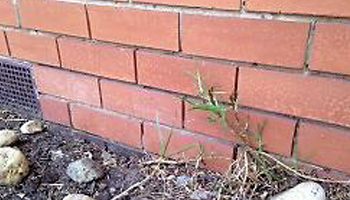
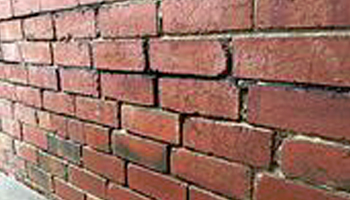
Rising Damp / Brick Mortar Deterioration:
Brickwork mortar joint cement pointing deteriorates due to absorption of moisture from damp ground conditions over time. Following completion of repair work, installation of a replacement damp proof course and re-pointing of affected brick mortar joints is recommended.
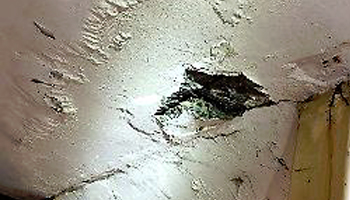
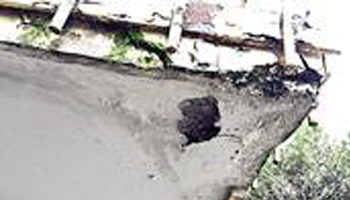
Concrete Spalling:
Concrete spalling (concrete cancer) happens because there is moisture in the concrete, forcing the surface to fall out or flake off.
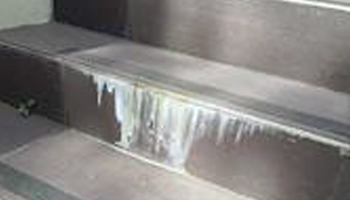
Salt Deposit / Dampness / Efflorescence:
Efflorescence describes the deposit of white mineral salts that appear on a surface (concrete, brick or mortar) which have leached out from within the surface when moisture travels through it.
Any efflorescence on the surface must be removed prior to painting, typically by an acid wash.
Paint which would normally stick to a surface can also be pushed off when the pressure caused by salt crystals building up beneath the paint.
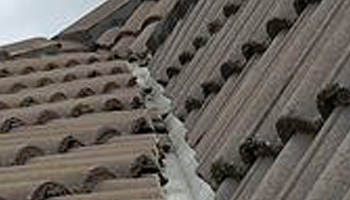
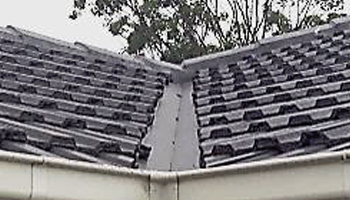
Roof Leak Potential:
This type of loose un-pointed roof valley tray/tile installation method is compliant with NCC, but is considered a potential leak point by our inspectors. Additionally, this valley style fails to retain cut roof tile pieces; we recommend flexible cement pointing to tile edges to retain cut pieces and improve weatherproofing in the event of heavy wind and rain conditions.
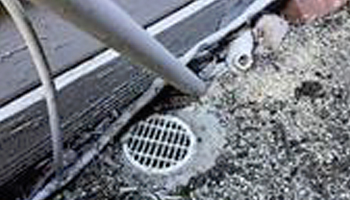
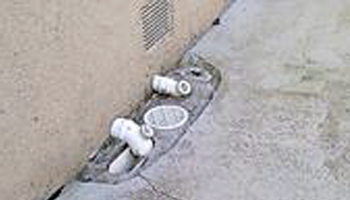
Sewer Vent & Rain Water Run-off:
Rain water surface run-off is capable of illegally entering the sewer due to adjacent raised ground/paving levels.
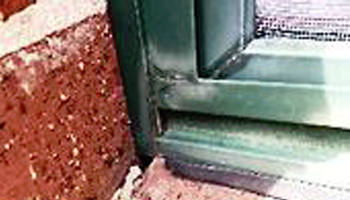
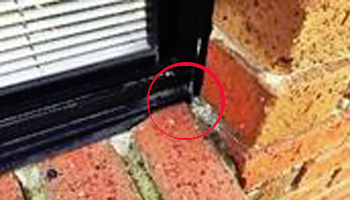
Window Sill Flashing:
Damaged and/or incorrectly installed window sill flashing enables the ingress of rainwater to the wall cavity; this defect can result in timber rot and damage to the internal wall frame.
Damaged cavity flashing common occurs during construction and is conducive to termite activity.
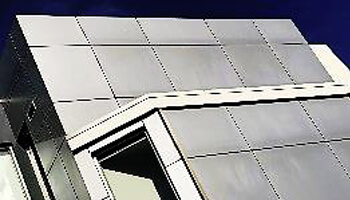
Polystyrene Foam Panelling
This type of exterior wall lining is a polystyrene or polyethylene aluminium sandwich panel ‘or foam panelling coated in acrylic render’ – this material is flammable and under review as to its suitability as an NCC approved building product;
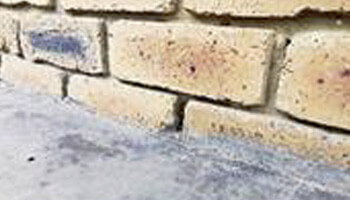
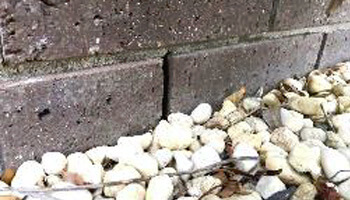
Compromised Weep Holes
Two examples of compromised house wall cavity weep holes
Weepholes are the gaps left between bricks in external walls and serve two important functions:
- Ventilation of the internal wall and sub house cavities: Without adequate ventilation, mildew, mold dry rot and rising damp can reduce the life of the internal wall studs and other elements within wall cavities.
- Drainage: Water that enters the cavity from condensation, damage, or flooding needs to escape. If these weep holes are fully or even partially blocked, water can build up and cause a wide variety of structural damage over time
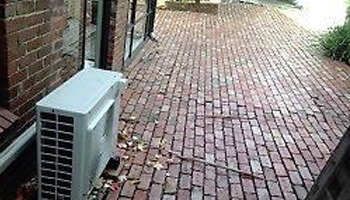
Raised Ground Level Issues
Raised garden beds, pathways or houses with paving on all sides can partially and/or fully block off sub-floor air ventilation and can result in the lowest area of ground on the property being the sub-floor space. This type of defect allows rain water run-off and ground seepage to enter this space resulting in the growth of mould, the creation of a termite conducive environment, deterioration to the timber structure, subsidence of the stumps and footings and consequential distortion damage to the house’s interior finishes.
In extreme cases, excavation may be required and a re-installation of properly drained surface paving and/or subterranean perforated agricultural drains.
Quick Fact:
“A 2009 report has shown that houses built between 1983 and 1997 in Victoria paid $4,245 on average to fix defects- an average of 4% of the sale value of a dwelling.”
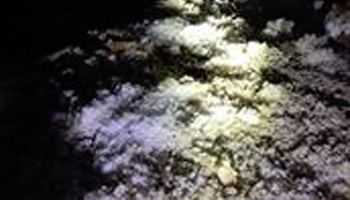
Mould:
Mould growth often occurs in the sub-floor crawl spaces and walls; spores are carried in the air and may cause health problems.
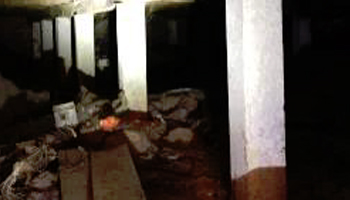
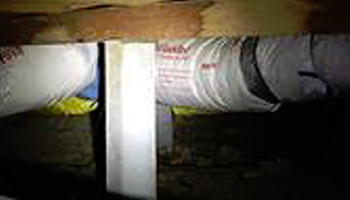
Floor Stump – Termite Caps:
Floor stumps should be fitted with metal termite caps to increase physical termite protection of the property. In a case like this, we recommend chemical termite treatment.

A detailed pest inspection is important to ensure the security, stability and hygiene of a structure.
“Termite infestations will obviously cause structural damage as they devour the wooden structure of a building, whereas rat infestations, cockroaches and other vermin can spread disease and damage electrical and structural elements within walls and under houses.”
Signs of termites:
Knocking or tapping sounds
One sign of a termite infestation is a clicking sound coming from within your walls or floors. Soldier termites bang their heads against timber and shake their bodies when their colony disturbed to signal danger.
Worker termites, on the other hand, are noisy eaters. You can actually hear them if you put your ear against any timber infested by termites.
White Ants
Termites are pale in colour: they are usually white but can sometimes look quite translucent. If you stumble upon a large number of whitish ants, it’s time for an inspection.
A termites’ antennae are completely straight, whereas most other ants have curved or elbowed antennae.
Flying termites
The first sign of a termite infestation is often the presence of flying termites or evidence of their corpses left behind. Flying termites are those that have left the colony to find a mate and create a new colony which is typically near or in your home.
Another sign of termites is their discarded wings as flying termites lose their wings shortly after finding a mate. After pairing up, termites crawl into a suitable nesting site where they seal themselves in and start a new colony.
Hollow sounding timber
Termites typically consume timber from the inside out which leaves a thin skin of wood or even just a layer of paint. When knocking or tapping on timber that has termite damage, you will hear a hollow sound because part or all of the wood has been consumed.
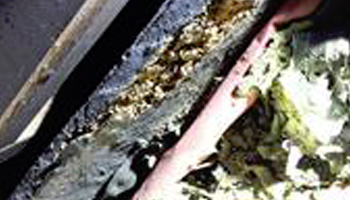
Termite Activity:
Evidence of past and/or present termite activity observed in a sub-floor area
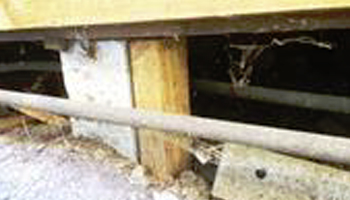
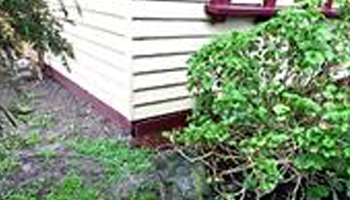
Termite Danger: Ground Contact with Timber Work
House timber members are in direct contact with the ground. This defect is conducive to termite activity and we would recommend an excavation of ground away from the structure sufficient to avoid both timber contact and rainwater surface run-off ingress to sub-floor area.
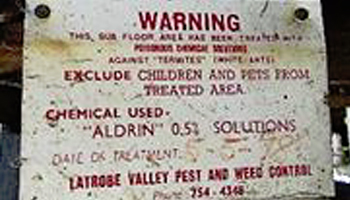
Termite – Banned Chemical:
Although not a sign of a current termite infestation, care should be taken if you see a sign like this on your property. In this case, Aldrin/Aldrex poison has been applied as termite treatment. This is now a banned chemical, do not make contact with this material.
Quick Fact:
Causing more damage to Australian homes than fire, floods and storms combined, termites are rightly feared by homeowners.
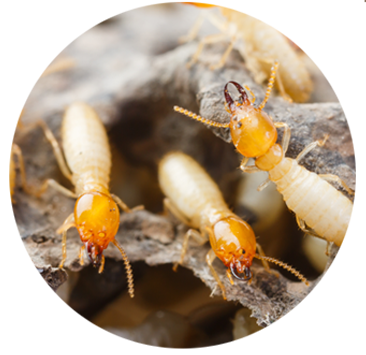
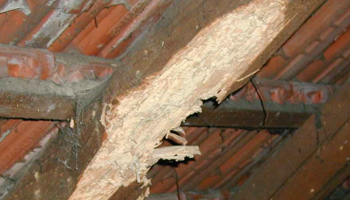
Borer Activity:
This is frass (waste from wood-eating insects) is from borer activity; affected timber requires removal and destruction by fire – seek the services of a carpenter.
How do you know if you’re dealing with termites or ants? The truth is that it can sometimes be difficult to tell, it’s always a good idea to get an official pest inspection to be absolutely sure.

The most common way for asbestos to enter the body is through breathing in its microscopic fibres. Typically, asbestos-containing materials are not considered to be harmful unless they are disturbed, releasing dust or fibers into the air where they can be inhaled or even ingested.
Once inhaled, asbestos fibers become trapped in the mucous membranes of the throat and nose where they can then be removed. However, some fibres may pass deeper into the lungs or into the digestive tract. Once this occurs, the fibers cannot be removed and can cause health problems decades later.
“Asbestos is most hazardous when it is friable. This is when the asbestos material is easily crumbled by hand and releasing fibers into the air. For example, sprayed on asbestos insulation is highly friable, whereas asbestos floor tiling is still a risk but less friable.”
Damage and deterioration will increase the friability of asbestos-containing materials over time. Water damage, continual vibration, and physical interaction such as drilling, buffing, cutting, sawing, or striking and grinding, can break the materials down making fiber release far more likely.
Things to remember:
- There is no safe level of exposure to asbestos fibers
- If asbestos is disturbed it can release dangerous dust containing asbestos fibers
- Breathing in dust containing asbestos fibres can cause asbestosis, lung cancer and mesothelioma decades later
- Mesothelioma is a type of cancer which most often occurs in the lining of the lung – there is no cure
- The risk of lung cancer from inhaling asbestos fibres is greatly increased if you are a smoker
- The average time between exposure to asbestos fibres and developing mesothelioma is around forty-five years
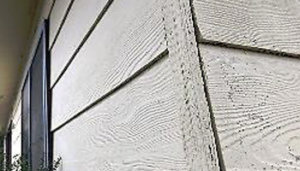
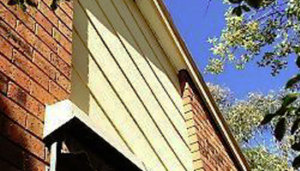
Asbestos Exterior Wall Lining:
Hardyplank, or similar product which is a faux weatherboard exterior wall lining material which contains asbestos.
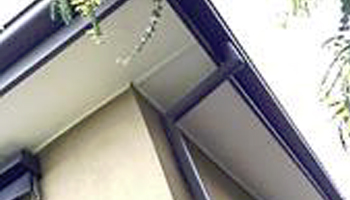
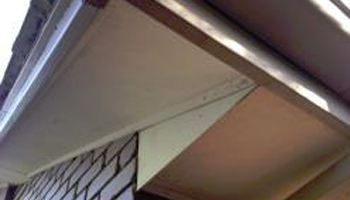
Asbestos Eave Sheeting:
Roof soffit (eave) lining sheet material is often assumed to contain a form of asbestos; sample lab testing is strongly recommended. Airborne asbestos particles are capable of entering the house through light fittings, exhaust, fans, air vents, cracks and gaps, etc. It is strongly recommended that all asbestos products, materials and contaminated materials are removed from the premises and a vacuum clean-up of affected areas is undertaken by a licensed asbestos contractor.
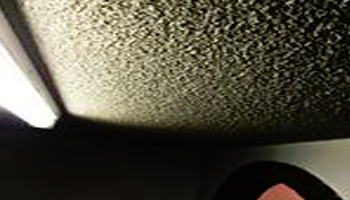
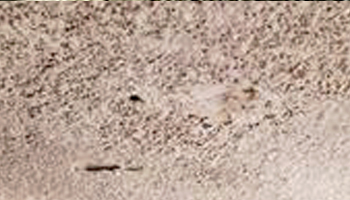
Vermiculite Ceiling Surface:
Ceiling surfaces (common throughout apartments of the 1960’s) have been coated in a material known as Vermiculite; some of this material can contain asbestos. Sample lab testing is strongly recommended.
Quick Fact:
“Asbestos can be found in a third of all Australian homes, according to the Asbestos Safety and Eradication Agency. In fact, if a property was built or renovated before 1992, it is likely that it contains asbestos.”
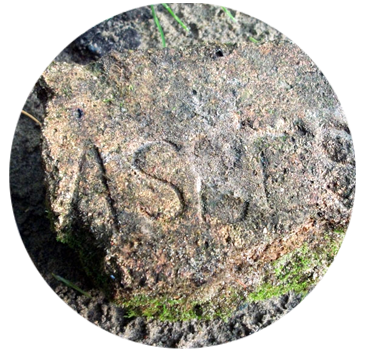
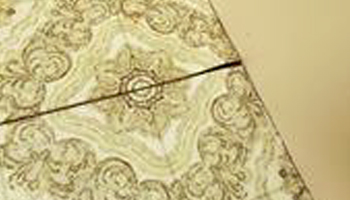
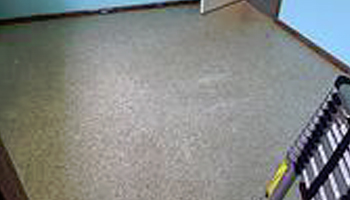
Asbestos Flooring and Tiles:
Older (pre-1992) vinyl floor material and/or tiles and underlay often contain asbestos. It’s always safer to conduct sample lab testing.
The Definitive Guide to Identifying Home Defects
We hope this guide has helped you to make informed decisions, identify potential issues around the house or save money on your next home.
To find out more about defects, home and building inspections or how Building Masters Inspections can help you save money, make your home safer and improve the market value of a building, contact us today on 1300 033 332 or via the contact form to the right.
DISCOUNTS AVAILABLE FOR MULTIPLE INSPECTIONS
